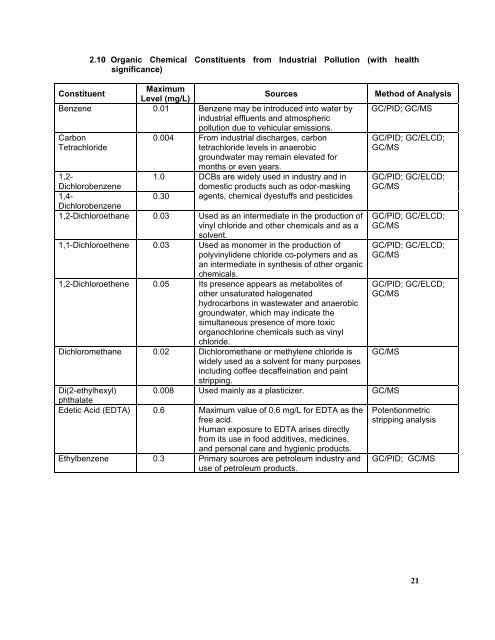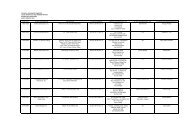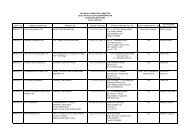Philippine National Standards for Drinking Water - LWUA
Philippine National Standards for Drinking Water - LWUA
Philippine National Standards for Drinking Water - LWUA
You also want an ePaper? Increase the reach of your titles
YUMPU automatically turns print PDFs into web optimized ePapers that Google loves.
2.10 Organic Chemical Constituents from Industrial Pollution (with health<br />
significance)<br />
Constituent<br />
Maximum<br />
Level (mg/L)<br />
Sources<br />
Benzene 0.01 Benzene may be introduced into water by<br />
industrial effluents and atmospheric<br />
pollution due to vehicular emissions.<br />
Carbon<br />
0.004 From industrial discharges, carbon<br />
Tetrachloride<br />
tetrachloride levels in anaerobic<br />
groundwater may remain elevated <strong>for</strong><br />
months or even years.<br />
DCBs are widely used in industry and in<br />
domestic products such as odor-masking<br />
agents, chemical dyestuffs and pesticides<br />
1,2-<br />
1.0<br />
Dichlorobenzene<br />
1,4-<br />
0.30<br />
Dichlorobenzene<br />
1,2-Dichloroethane 0.03 Used as an intermediate in the production of<br />
vinyl chloride and other chemicals and as a<br />
solvent.<br />
1,1-Dichloroethene 0.03 Used as monomer in the production of<br />
polyvinylidene chloride co-polymers and as<br />
an intermediate in synthesis of other organic<br />
chemicals.<br />
1,2-Dichloroethene 0.05 Its presence appears as metabolites of<br />
other unsaturated halogenated<br />
hydrocarbons in wastewater and anaerobic<br />
groundwater, which may indicate the<br />
simultaneous presence of more toxic<br />
organochlorine chemicals such as vinyl<br />
chloride.<br />
Dichloromethane 0.02 Dichloromethane or methylene chloride is<br />
widely used as a solvent <strong>for</strong> many purposes<br />
including coffee decaffeination and paint<br />
stripping.<br />
Method of Analysis<br />
GC/PID; GC/MS<br />
GC/PID; GC/ELCD;<br />
GC/MS<br />
GC/PID; GC/ELCD;<br />
GC/MS<br />
GC/PID; GC/ELCD;<br />
GC/MS<br />
GC/PID; GC/ELCD;<br />
GC/MS<br />
GC/PID; GC/ELCD;<br />
GC/MS<br />
GC/MS<br />
Di(2-ethylhexyl) 0.008 Used mainly as a plasticizer. GC/MS<br />
phthalate<br />
Edetic Acid (EDTA) 0.6 Maximum value of 0.6 mg/L <strong>for</strong> EDTA as the<br />
free acid.<br />
Human exposure to EDTA arises directly<br />
from its use in food additives, medicines,<br />
and personal care and hygienic products.<br />
Ethylbenzene 0.3 Primary sources are petroleum industry and<br />
use of petroleum products.<br />
Potentionmetric<br />
stripping analysis<br />
GC/PID; GC/MS<br />
21







